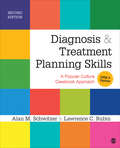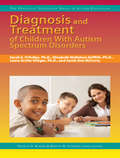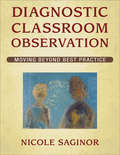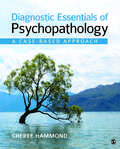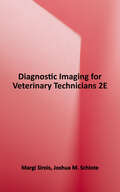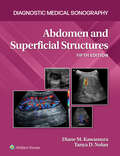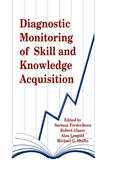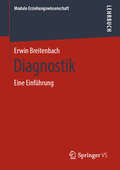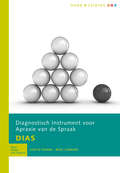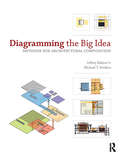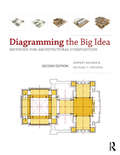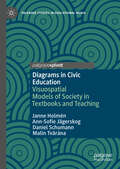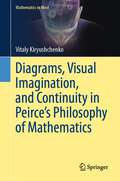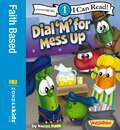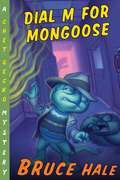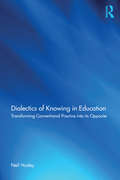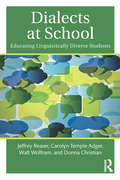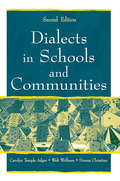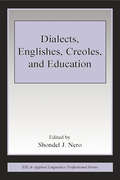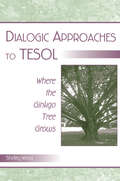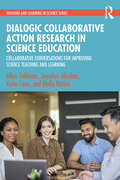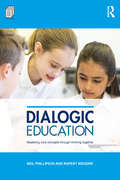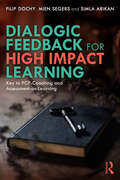- Table View
- List View
Diagnosis and Treatment Planning Skills: A Popular Culture Casebook Approach (DSM-5 Update)
by Lawrence C. Rubin Dr Alan M. SchwitzerThe Second Edition of Alan M. Schwitzer and Lawrence C. Rubin’s Diagnosis and Treatment Planning Skills: A Popular Culture Casebook Approach comprehensively addresses the clinical thinking skills required in professional counseling settings through the innovative use of case examples drawn from popular culture. Fully revised to include DSM-5, the text begins with discussion of diagnosis, case conceptualization, and treatment planning, covering the interplay of individual clinical tools and their application in contemporary practice. Ten DSM-5 updated case illustrations follow, creating a streamlined new edition that engages students in a start-to-finish application of clinical tools.
Diagnosis and Treatment of Children With Autism Spectrum Disorders
by Sarah E. O'Kelley Elizabeth Mcmahon Griffith Laura Grofer Klinger Sarah Ann MccurryThis new series offers timesaving books on critical topics for educating students with autism spectrum disorders. The four books in this series are filled with practical information and advice, thus making them an ideal resource for classroom teachers, preservice teachers, and graduate students. This book provides an overview of the screening procedures and diagnostic criteria for students with autism spectrum disorders. The most current, research-based treatment therapies for students with this diagnosis also are presented.
Diagnostic Classroom Observation: Moving Beyond Best Practice
by Nicole SaginorA complete instructional leadership system for improving classroom practice! Based on the Vermont Classroom Observation Tool, diagnostic classroom observation (DCO) provides principals with guidance for the entire instructional supervision process, from preconference analysis to postconference follow-up. The model includes protocols for observing math/science and literacy instruction, criteria for recognizing exceptional teaching, and standards for determining classroom quality and student engagement. Readers will also find: Classroom observation forms to help identify instructor strengths and weaknesses; Scoring forms to assist with the final evaluation and review process; Real-world vignettes that illustrate key indicators of quality teaching; Guidance for introducing DCO into any school setting.
Diagnostic Essentials of Psychopathology: A Case-Based Approach
by Cheree F. HammondDiagnostic Essentials of Psychopathology: A Case-Based Approach by Cheree Hammond brings together dozens of fictional cases which represent a range of human experiences, featuring people of different ages, ethnicities, genders, ability levels, and religions. Each disorder has several cases associated with it to capture the truly unique nature of working with various client intersections, and half of the cases provide the correct "answers" or diagnosis to allow students to check their understanding of this process. Some cases focus on a diagnosis, others with analysis, and others let the student practice on their own as a way to further student reflection and learning. This casebook is specifically written for disciplines that are grounded in a humanistic approach (Counseling, Social Work, Counseling Psychology). The author provides a framework for using the medical model that is presented in the DSM-5.
Diagnostic Essentials of Psychopathology: A Case-Based Approach
by Cheree F. HammondDiagnostic Essentials of Psychopathology: A Case-Based Approach by Cheree Hammond brings together dozens of fictional cases which represent a range of human experiences, featuring people of different ages, ethnicities, genders, ability levels, and religions. Each disorder has several cases associated with it to capture the truly unique nature of working with various client intersections, and half of the cases provide the correct "answers" or diagnosis to allow students to check their understanding of this process. Some cases focus on a diagnosis, others with analysis, and others let the student practice on their own as a way to further student reflection and learning. This casebook is specifically written for disciplines that are grounded in a humanistic approach (Counseling, Social Work, Counseling Psychology). The author provides a framework for using the medical model that is presented in the DSM-5.
Diagnostic Imaging for Veterinary Technicians, 2E
by Margi Sirois Joshua M. SchloteDiagnostic Imaging for Veterinary Technicians is a comprehensive diagnostic imaging textbook, which includes detailed positioning information for radiographic studies in the small animal clinic. The text showcases a systematic approach to the positioning of feline, canine, equine, and exotic animal patients for routine and special radiographic procedures, including dentistry procedures.
Diagnostic Medical Sonography Series: Abdomen and Superficial Structures
by Diane Kawamura Tanya NolanPart of the highly regarded Diagnostic Medical Sonography series, Diane M. Kawamura and Tanya D. Nolan’s Abdomen and Superficial Structures, 5th Edition, thoroughly covers the core content students need to master in today’s rigorous sonography programs. Careful, collaborative editing ensures consistency across all three titles in this series: The Vascular System, Abdomen and Superficial Structures, and Obstetrics and Gynecology, providing the right content at the right level for both students and instructors.
Diagnostic Monitoring of Skill and Knowledge Acquisition
by Robert Glaser Norman Frederiksen Alan Lesgold Michael G. ShaftoAn adjunct to the increased emphasis on developing students' critical thinking and higher order skills is the need for methods to monitor and evaluate these abilities. These papers provide insight into current techniques and examine possibilities for the future. The contributors to Diagnostic Monitoring of Skill and Knowledge Acquisition focus on two beliefs: that new kinds of tests and assessment methods are needed; and that instruction and learning can be improved by developing new assessment methods based on work in cognitive science.
Diagnostik: Eine Einführung (Module Erziehungswissenschaft #5)
by Erwin BreitenbachDas Buch liefert Basiswissen, das Studierende mit soliden und umfassenden diagnostischen Kompetenzen für den künftigen Unterrichtsalltag in der Schule ausstattet. Neben Konzepten und Begriffen zur Evaluation des Lehrens – Lernverlaufsdiagnostik, werden verschiedene Methoden erläutert, mit denen nicht erwartungsgemäße Lernverläufe analysiert werden können. Gezielt werden Curriculum nahe und im Unterricht leicht einsetzbare Verfahren gezeigt, die den Erfordernissen inklusiven Unterrichtens entsprechen.Der InhaltTheoretische Grundlegungen von Diagnostik • Lernverlaufsdiagnostik • Förderdiagnostik • Fallbeispiel zur Förderdiagnostik • Aktueller Forschungsstand zur pädagogischen DiagnostikDer AutorDr. Erwin Breitenbach ist Professor für Rehabilitationspsychologie an der Humboldt Universität zu Berlin.
Diagnostisch Instrument voor Apraxie van de Spraak (DIAS) handleiding
by Judith Feiken Roel JonkersDoel van de testHet Diagnostisch Instrument voor Apraxie van de Spraak (DIAS) is een instrument waarmee de diagnose ‘spraakapraxie’ gesteld wordt. Daarnaast kan met het DIAS de ernst van de spraakapraxie worden bepaald. Het DIAS is het eerste betrouwbare en gestandaardiseerde instrument voor het specifiek diagnosticeren van spraakapraxie, los van eventueel aanwezige andere stoornissen, zoals afasie en / of dysartrie. Met de test legt men een goede basis voor een passend therapieplan voor de patientgroep met spraakapraxie en het instrument brengt het effect in kaart van specifiek op spraakapraxie gerichte therapie. Het DIAS onderzoekt de aard van de spraakapraxie door na te gaan welke specifieke symptomen van de stoornis aanwezig zijn en in welke mate. Daarnaast bepaalt het instrument het niveau van de doelbewuste articulatie, waarmee de ernst van de spraakapraxie in kaart wordt gebracht. Met het DIAS onderzoekt men patiënten bij wie een vermoeden bestaat dat er sprake is van spraakapraxie of waarbij al is vastgesteld dat er sprake is van spraakapraxie. Het instrument is geschikt om af te nemen aan het eind van de acute fase en bij de aanvang van de revalidatiefase. Om logopedische therapie te kunnen evalueren wordt geadviseerd het DIAS met tussenpozen van 3 maanden af te nemen en de uitkomsten van de afnamen te vergelijken.Toepassing• Diagnose: stelt de diagnose spraakapraxie en bepaalt de ernst van de stoornis.• Differentiaaldiagnose: onderscheidt spraakapraxie van afasie en dysartrie.• Behandeling: helpt bij het maken van een passend therapieplan.• Evaluatie: bepaalt het effect van gegeven therapie• Onderzoek: levert een bijdrage aan o.a. therapie- effectstudiesWat meet het DIAS?Het DIAS bevat vier taken, gericht op de articulatorisch- motorische programmering:1. aansturing van de articulatiespieren, los van de spraak (buccofaciaal)2. bewuste articulatie van individuele klanken3. diadochokinese (afwisselen van articulatieplaats en -wijze)4. articulatie van woorden met een toenemende articulatiecomplexiteitMet deze vier taken worden de specifieke kenmerken van de spraakapraxie en de ernst van stoornis vastgesteld.Voor wie?Het DIAS kan worden afgenomen zonder specifieke kennis over de achtergronden van spraakapraxie. Scoring en interpretatie mogen echter alleen worden uitgevoerd door professionals die deze kennis wel hebben. Afname en scoringAlle taken van het DIAS worden op multimodale (mondeling en schriftelijk) wijze aangeboden. Dit heeft als doel de invloed van eventueel aanwezige fatische stoornissen zoveel mogelijk te vermijden. De afname verloopt in een vaste volgorde, bij voorkeur achter elkaar door en duurt 30 tot 45 minuten. Elke afname wordt opgenomen op video en achteraf gescoord.NormenDe diagnose spraakapraxie wordt gesteld op basis van een cutoff-score met betrekking tot het aantal aanwezige kenmerken in combinatie met de aanwezigheid van combinaties van specifieke kenmerken. De interpretatie van de ernstscores wordt uitgevoerd met behulp van normtabellen. Er kan een vergelijking worden gemaakt met de scores van patiënten met spraakapraxie (percentielen) en met de scores van mensen zonder spraakstoornis (gemiddelden).Materialen• Diagnostisch Instrument voor Apraxie van de Spraak (DIAS) — complete set • Diagnostisch Instrument voor Apraxie van de Spraak (DIAS) — scoreformulieren (25)• Diagnostisch Instrument voor Apraxie van de Spraak (DIAS) — handleiding
Diagramming the Big Idea: Methods for Architectural Composition
by Jeffrey Balmer Michael T. SwisherAs a beginning design student, you need to learn to think like a designer, to visualize ideas and concepts, as well as objects. In Diagramming the Big Idea, Jeffrey Balmer and Michael T. Swisher illustrate how you can create and use diagrams to clarify your understanding of both particular projects and organizing principles and ideas. With accessible, step-by-step exercises that interweave diagrams, drawings and virtual models, the authors clearly show you how to compose meaningful and useful diagrams. As you follow the development of the four project groups drawn from the authors’ teaching, you will become familiar with architectural composition concepts such as proportion, site, form, hierarchy and spatial construction. In addition, description and demonstration essays extend concepts to show you more examples of the methods used in the projects. Whether preparing for a desk critique, or any time when a fundamental insight can help to resolve a design problem, this book is your essential studio resource.
Diagramming the Big Idea: Methods for Architectural Composition
by Jeffrey Balmer Michael T. SwisherBecoming an architect is a daunting task. Beyond the acquisition of new skills and procedures, beginning designers face an entirely unfamiliar mode of knowledge: design thinking. In Diagramming the Big Idea, Jeffrey Balmer and Michael T. Swisher introduce the fundamentals of design thinking by illustrating how architects make and use diagrams to clarify their understanding of both specific architectural projects and universal principles of form and order. With accessible, step-by-step procedures that interweave diagrams, drawings and virtual models, the authors demonstrate how to compose clear and revealing diagrams. Design thinking defines a method for engaging the world through observation and analysis. Beyond problem solving, design is a search for possibilities. Mastering design thinking begins with learning the fundamentals of visual composition. It embraces the ability to synthesize deductive and imaginative reasoning, combining both shrewd scrutiny and fevered speculation. Design diagrams make visible the abstractions that order the built environment. Premised upon the Beaux-Arts notion of the architectural parti, Balmer and Swisher adopt the ‘Big Idea’ as a foil and as a suitcase to organize fundamentals of architectural composition. The goal of this book is to make explicit to students what they are learning, why they are learning it and how to internalize such lessons toward their lifelong development as designers.
Diagrams in Civic Education: Visuospatial Models of Society in Textbooks and Teaching (Palgrave Studies in Educational Media)
by Janne Holmén Daniel Schumann Ann-Sofie Jägerskog Malin TvärånaThis book presents the findings of three studies on the use of diagrams in civic education. The first study presents an international comparison of textbook diagrams promoting national unity in diversity, with examples from ten countries. The second focuses on the depiction of migration in diagrammatic form in German textbooks, The final study was conducted in collaboration with teachers in Swedish social science classrooms, and focuses on teaching comprehension of flow charts and scatterplots. The book will be of interest to scholars of educational media, didactics, the history of education and citizenship education.
Diagrams, Visual Imagination, and Continuity in Peirce's Philosophy of Mathematics (Mathematics in Mind)
by Vitaly KiryushchenkoThis book is about the relationship between necessary reasoning and visual experience in Charles S. Peirce’s mathematical philosophy. It presents mathematics as a science that presupposes a special imaginative connection between our responsiveness to reasons and our most fundamental perceptual intuitions about space and time. Central to this view on the nature of mathematics is Peirce’s idea of diagrammatic reasoning. In practicing this kind of reasoning, one treats diagrams not simply as external auxiliary tools, but rather as immediate visualizations of the very process of the reasoning itself. Thus conceived, one's capacity to diagram their thought reveals a set of characteristics common to ordinary language, visual perception, and necessary mathematical reasoning. The book offers an original synthetic approach that allows tracing the roots of Peirce’s conception of a diagram in certain patterns of interrelation between his semiotics, his pragmaticist philosophy, his logical and mathematical ideas, bits and pieces of his biography, his personal intellectual predispositions, and his scientific practice as an applied mathematician.
Dial 'M' for Mess Up: Level 1 (I Can Read! / Big Idea Books / VeggieTales)
by Karen PothA Lesson in ForgivenessWhen Percy loses Laura&’s money, Laura forgives him. But when Junior loses Percy&’s money accidentally, Percy doesn&’t forgive at all! Time to &“Dial &‘M&’ for Mess Up!&”This is a Level One I Can Read! book, which means it&’s perfect for children learning to sound out words and sentences. It aligns with guided reading level J and will be of interest to children Pre-K to 3rd grade.
Dial M for Mongoose
by Bruce HaleChet Gecko's investigations often show him the seamy underbelly of school life, but this case throws him for a loop. A deadly stink bomb is unleashed, a school building falls to rubble, money goes missing from the principal's office, and that's just a start. Chet's endurance for trouble is tested, but so is his loyalty: Someone is trying to get his mongoose janitor pal Maureen DeBree fired. A true-blue P.I. doesn't take that kind of monkey business lying down. Standing up, maybe.And stand up he will-to some very shifty school bullies. Chet keeps digging for the truth like a mole after an earthworm sandwich. Oh, foolish detective.
Dialectics of Knowing in Education: Transforming Conventional Practice into its Opposite
by Neil HooleyDialectics of Knowing in Education strengthens the philosophical basis of formal education that has been weakened by neoliberalism over the past 30 years. It theorises and encourages human existence based on social action, culture, inquiry and creativity so that citizens in democratic association can formulate their own understandings of the world and be their own philosophers of practice. <P><P>Under neoliberal capitalism, formal education has become a key economic driver and factor for all countries, but has exacerbated social division and inequality. This has led to an increased pressure on education systems to emphasise individual gain and prosperity at the expense of community care and concern. Drawing on the work of Dewey, Mead, Freire and Biesta, the author argues that formal education at all levels must be transformed so that it does not seek to impose knowledge and truth, but situates knowledge as being constructed by democratic learning circles of staff, students and citizens. <P><P>Focusing particularly on the notion of praxis and specific issues involving Indigenous, feminist and practitioner knowing, this book will help scholars, practitioners and policy makers to transform their education theories and practices in ways that encourage democracy, emancipation, social action, culture, inquiry and creativity.
Dialects at School: Educating Linguistically Diverse Students
by Walt Wolfram Jeffrey Reaser Carolyn Temple Adger Donna ChristianLike its predecessor, Dialects in Schools and Communities, this book illuminates major language-related issues that educational practitioners confront, such as responding to dialect related features in students’ speech and writing, teaching Standard English, teaching students about dialects, and distinguishing dialect difference from language disorders. It approaches these issues from a practical perspective rooted in sociolinguistic research, with a focus on the research base for accommodating dialect differences in schools. Expanded coverage includes research on teaching and learning and attention to English language learners. All chapters include essential information about language variation, language attitudes, and principles of handling dialect differences in schools; classroom-based samples illustrating the application of these principles; and an annotated resources list for further reading. The text is supported by a Companion Website (www.routledge.com/cw/Reaser) providing additional resources including activities, discussion questions, and audio/visual enhancements that illustrate important information and/or pedagogical approaches. Comprehensive and authoritative, Dialects at School reflects both the relevant research bases in linguistics and education and educational practices concerning language variation. The problems and examples included are authentic, coming from the authors’ own research, observations and interactions in public school classrooms, and feedback in workshops. Highlights include chapters on oral language and reading and writing in dialectally diverse classrooms, as well as a chapter on language awareness for students, offering a clear and compelling overview of how teachers can inspire students to learn more about language variation, including their own community language patterns. An inventory of dialect features in the Appendix organizes and expands on the structural descriptions presented in the chapters.
Dialects in Schools and Communities
by Walt Wolfram Carolyn Temple Adger Donna ChristianThis book describes dialect differences in American English and their impact on education and everyday life. It explores some of the major issues that confront educational practitioners and suggests what practitioners can do to recognize students’ language abilities, support their language development, and expand their knowledge about dialects. Topics addressed include:*popular concerns about the nature of language variation;*characteristic structures of different dialects;*various interactive patterns characteristic of social groups;*the school impacts of dialect differences in speaking, writing, and reading, including questions about teaching Standard English; and*the value of dialect education in schools to enable students to understand dialects as natural and normal language phenomena. Changes in the Second Edition: In this edition the authors reconsider and expand their discussion of many of the issues addressed in the first edition and in other of their earlier works, taking into account especially the research on dialects and publications for audiences beyond linguistics that have appeared since the first edition. This edition is offered as an updated report on the state of language variation and education in the United States. Dialects in Schools and Communities is rooted in questions that have arisen in workshops, surveys, classes, discussion groups, and conversations with practitioners and teacher educators. It is thus intended to address important needs in a range of educational and related service fields. As an overview of current empirical research, it synthesizes current understandings and provides key references—in this sense it is a kind of translation and interpretation in which the authors’ goal is to bring together the practical concerns of educators and the vantage point of sociolinguistics. No background in linguistics or sociolinguistics is assumed on the part of the reader. This volume is intended for teacher interns and practicing teachers in elementary and secondary schools; early childhood specialists; specialists in reading and writing; speech/language pathologists; special education teachers; and students in various language specialties.
Dialects, Englishes, Creoles, and Education (ESL & Applied Linguistics Professional Series)
by Shondel J. NeroThis volume brings together a multiplicity of voices--both theoretical and practical--on the complex politics, challenges, and strategies of educating students--in North America and worldwide--who are speakers of diverse or nonstandard varieties of English, creoles, and hybrid varieties of English, such as African American Vernacular English, Caribbean Creole English, Tex Mex, West African Pidgin English, and Indian English, among others. The number of such students is increasing as a result of the spread of English, internal and global migration, and increased educational access. Dialects, Englishes, Creoles, and Education offers:*a sociohistorical perspective on language spread and variation;*analysis of related issues such as language attitudes, identities, and prescribed versus actual language use; and*practical suggestions for pedagogy.Pedagogical features: Key points at the beginning of each chapter help focus the reader and provide a framework for reading, writing, reflection, and discussion; chapter-end questions for discussion and reflective writing engage and challenge the ideas presented and encourage a range of approaches in dealing with language diversity. Collectively, the chapters in this volume invite educators, researchers, and students, across the fields of TESOL, applied linguistics, sociolinguistics, English, literacy, and language education, to begin to consider and adopt context-specific policies and practices that will improve the language development and academic performance of linguistically diverse students.
Dialogic Approaches to TESOL: Where the Ginkgo Tree Grows
by Shelley WongThis book locates dialogic pedagogy within the history of TESOL approaches and methods in which the communicative approach has been the dominant paradigm. Dialogic inquiry in the form of story telling, oral histories, and knowledge from the ground up and from the margins has much to offer the field. In dialogic approaches, the teacher and students learn in community and the students' home languages and cultures, their families and communities, are seen as resources.Dialogic Approaches to TESOL: Where the Ginkgo Tree Grows explores teacher research, feminist contributions to voice, social identity and dialogic pedagogy, and the role of teachers, students, families, and communities as advocates and change agents. After a brief history of TESOL methods and an introduction to dialogic pedagogy, four features of dialogic approaches to TESOL are identified and discussed: learning in community, problem-posing, learning by doing, and who does knowledge serve? The main text in each chapter considers a single topic related to the concept of dialogic pedagogy. Branching text leads to related discussions without losing the main point of the chapter. This structure allows readers to become well-rooted in each component of dialogic pedagogy and to "branch out" into deeper philosophic understandings as well as actual practices across a range of contexts.Dialogic Approaches to TESOL offers a place for dialogue and reflection on the prospects for transforming educational institutions to serve those who have historically been excluded and marginalized. It provides questions, frameworks, and resources for those who are just beginning in the field and for U.S.-based educators who want to bring critical multicultural and multilingual perspectives into language arts, reading and literacy education.
Dialogic Collaborative Action Research in Science Education: Collaborative Conversations for Improving Science Teaching and Learning (ISSN)
by Allan Feldman Jawaher Alsultan Katie Laux Molly NationThis engaging and practical book offers science teacher educators and K-12 science teachers alike the tools to engage in a dialogic mode of collaborative action research (D-CAR), a collaborative mode of action research focused on teachers’ experiences with students, reflection upon these experiences, and peer learning.Renowned science educator Allan Feldman and co-authors from across numerous settings in K-12 science education present the theory, methodology, case studies, and practical advice to support the use of D-CAR as a means to enhance teachers’ normal practice and address the problems, dilemmas, and dissonances that science teachers must negotiate as they work to meet the needs of an increasingly diverse student population and engage with complex science teaching challenges that disproportionately affect marginalized students.The book will be of use to science teacher educators, pre-service and in-service science teachers, professional development specialists, or any science educator invested in developing creative, reflective, and thoughtful teachers.
Dialogic Collaborative Action Research in Science Education: Collaborative Conversations for Improving Science Teaching and Learning (Teaching and Learning in Science Series)
by Allan Feldman Jawaher Alsultan Katie Laux Molly NationThis engaging and practical book offers science teacher educators and K-12 science teachers alike the tools to engage in a dialogic mode of collaborative action research (D-CAR), a collaborative mode of action research focused on teachers’ experiences with students, reflection upon these experiences, and peer learning. Renowned science educator Allan Feldman and co-authors from across numerous settings in K-12 science education present the theory, methodology, case studies, and practical advice to support the use of D-CAR as a means to enhance teachers’ normal practice and address the problems, dilemmas, and dissonances that science teachers must negotiate as they work to meet the needs of an increasingly diverse student population and engage with complex science teaching challenges that disproportionately affect marginalized students. The book will be of use to science teacher educators, pre-service and in-service science teachers, professional development specialists, or any science educator invested in developing creative, reflective, and thoughtful teachers.
Dialogic Education: Mastering core concepts through thinking together (Computer-Supported Collaborative Learning Series #7)
by Rupert Wegerif Neil PhillipsonDialogue has long been used in primary classrooms to stimulate thinking, but it is not always easy to unite the creative thinking of good dialogue with the need for children to understand the core concepts behind knowledge-rich subjects. A sound understanding of key concepts is essential to progress through the national curriculum, and assessment of this understanding along with effective feedback is central to good practice. Dialogic Education builds upon decades of practical classroom research to offer a method of teaching that applies the power of dialogue to achieving conceptual mastery. Easy-to-follow template lesson plans and activity ideas are provided, each of which has been tried and tested in classrooms and is known to succeed. Providing a structure for engaging children and creating an environment in which dialogue can flourish, this book is separated into three parts: Establishing a classroom culture of learning; Core concepts across the curriculum; Wider dialogues: Educational adventures in the conversation of mankind. Written to support all those in the field of primary education, this book will be an essential resource for student, trainee and qualified primary teachers interested in the educational importance of dialogue.
Dialogic Feedback for High Impact Learning: Key to PCP-Coaching and Assessment-as-Learning
by Filip Dochy Mien Segers Simla ArikanIn recent years, the transmission paradigm of learning and teaching is making way for new approaches fuelled in part by the technology and AI revolutions. Learning is seen now more often in the light of connectivism, collaboration and creative problem solving. Dialogic Feedback for High Impact Learning explores this fascinating trend championing learning as a dialogic process between learners and coaches where learning is connecting networks and resources and leads to creative problem solving. It addresses the need for feedback as a dialogue in training for tomorrow, what it entails and how you can best deal with it. The book explores the power of feedback in a high-impact learning setting, where all parties strive for a learning and feedback culture rather than a consumption and testing culture. The authors discuss the feedback process, feedback seeking behaviour and the quality of the feedback message, sharing tips for software and apps to support this process and how teachers and coaches from a variety of settings have integrated the feedback dialogue into their training. This book is intended for everyone who wants to contribute to the learning culture of tomorrow, including learning coaches, managers, education and training professionals, and teachers and trainees at all levels in education.
